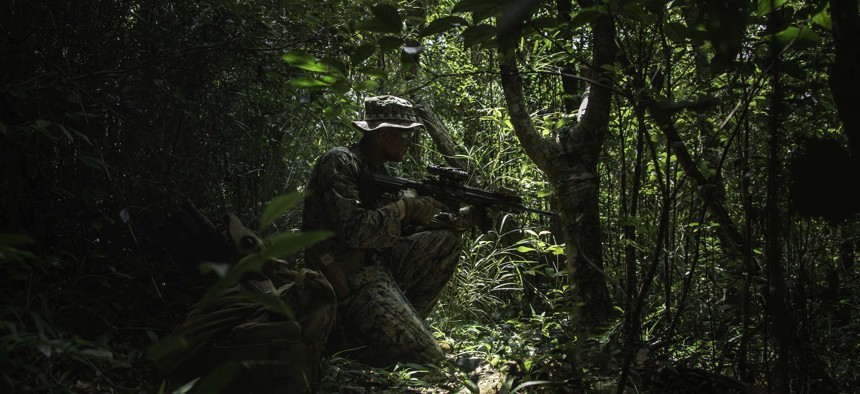
U.S. Marine Lance Cpl. Jonathan Arreguinperez, a rifleman assigned to 2nd Battalion, 3rd Marine Regiment, 3rd Marine Division, sets security during Indo-Pacific Warfighting Exercise on Okinawa, Japan, August 31, 2021. U.S. Marine Corps / Lance Cpl. Scott Aubuchon
US Needs Indo-Pacific Force ‘Enhancements,’ Global Posture Review Finds
Few details released from classified review, which arrives amid geopolitical shifts.
The Biden administration has approved the Pentagon’s 2021 Global Posture Review, which calls for more rotations and presence in the Indo-Pacific at the cost of military presence in other areas—even as the U.S. watches escalating aggression by Russia against Ukraine and recalibrates how it will counter terror groups and contain Iran in the Middle East.
“The impact of this guidance will manifest itself through dozens, if not hundreds of routine posture-related decisions over the next two to three years,” said a senior defense official who briefed reporters Monday on the general conclusions of the review, which is classified.
“Direction from the GPR will strengthen the department's focus on China by reducing posture requirements in other theaters to enable improved warfighting readiness and increase activities in the Indo Pacific.”
Many of the changes under discussion with partner nations will not be announced, and the details of the review will remain classified, the official said. The Pentagon has promised to release an unclassified fact sheet.
The Pentagon has already begun implementing some of these Indo-Pacific force posture improvements. Earlier this year, it announced DOD would permanently station a previously rotational attack helicopter squadron and an artillery division headquarters in the Republic of Korea. It has begun spending billions to improve shipyards at Guam and other unidentified locations in the Indo-Pacific. It is also developing air base alternatives throughout the region. In April, Australia announced it would spend $750 million to upgrade four of its bases as it increases its participation in U.S.-led naval exercises.
The Global Posture Review is being released as the U.S. ends a 20-year war effort in Iraq and Afghanistan but still seeks to curb Iranian influence there, and while the U.S. monitors with concern Russian buildup along the Ukrainian border.
The official would not say what posture changes the U.S. might make in the European theater to counter Russia, but said the administration was “working real time with allies and partners to further strengthen that combat-credible deterrent.”
The officials also declined to say whether the Pacific moves would include a return of large-scale exercises such as Foal Eagle or Ulchi Freedom Guardian, or whether South Korea would get more than the 28,500 U.S. troops already based there. The large-scale exercises were cancelled by the Trump administration as it pressed denuclearization talks with North Korea, although some “low key” joint drills have resumed.
“China is the pacing challenge for the department. And I think you'll see a strong commitment in the forthcoming [National Defense Strategy] as well that will guide further posture enhancements,” the official said.
As for South Korea, the official said, “We do not have a specific number to note today in terms of change in Korea. We remain committed to the mission and requirements there. There is no change that we're announcing today.”
The GPR did not address forces in Afghanistan “due to the separate NSC-led interagency process that was reviewing the way ahead for U.S. presence there.” Nor did it address the military’s rising concern about space, cyber and nuclear capabilities, because of the review’s focus on overseas force posture requirements, the official said. Those other realms will be addressed in the forthcoming Nuclear Posture Review, Missile Defense Strategy, and National Defense Strategy, the official said.
The review also “gets the department's posture decision making back into a coordinated business-as-usual process,” the official said. This means re-establishing civilian and allied consultation that had been undercut by surprise announcements during the Trump presidency, such as his announcement to withdraw forces from Syria or cut force levels in Germany.
“On a number of occasions in the previous administration, posture decisions were made and announced without a delivery process and without due consideration of global trade-offs, risk to strategy, interagency coordination and impact to allies and partners,” the official said. “We designed an approach to the GPR that would reassert civilian leadership and strategic prioritization.”




